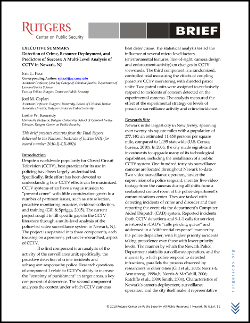
Despite a worldwide popularity for Closed Circuit Television (CCTV), best‐practices for its use in policing have been largely understudied. Specifically, little effort has been devoted to understanding how CCTV effects can be maximized. CCTV systems often have a vague mission to “prevent crime” with little consideration given to a number of pertinent issues, such as site selection, proactive monitoring practices, evidence collection, and training (Gill & Spriggs, 2005). The current project sought to fill specific gaps in the CCTV literature through a multi‐level analysis of the police‐led video surveillance system in Newark, NJ. The project is separated into three components, each focusing on a pertinent, yet under‐researched, aspect of CCTV.
The first component is an analysis of the activity of the surveillance unit; specifically, the proactive detection of crime incidents and subsequent response by police. Research questions of component 1 relate to CCTV’s ability to increase the “certainty of punishment” in target areas, a key component of deterrence. The second component analyzes the context under which CCTV cameras best deter crime. The statistical analysis tested the influence of several micro‐level factors (environmental features, line‐of‐sight, camera design and enforcement activity) on changes in CCTV viewsheds. The third component is a randomized, controlled trial measuring the effects of coupling proactive CCTV monitoring with directed patrol units: Two patrol units were assigned to exclusively respond to incidents of concern detected on the experimental cameras. The analysis measured the effect of the experimental strategy on levels of proactive surveillance activity and crime incidence.
